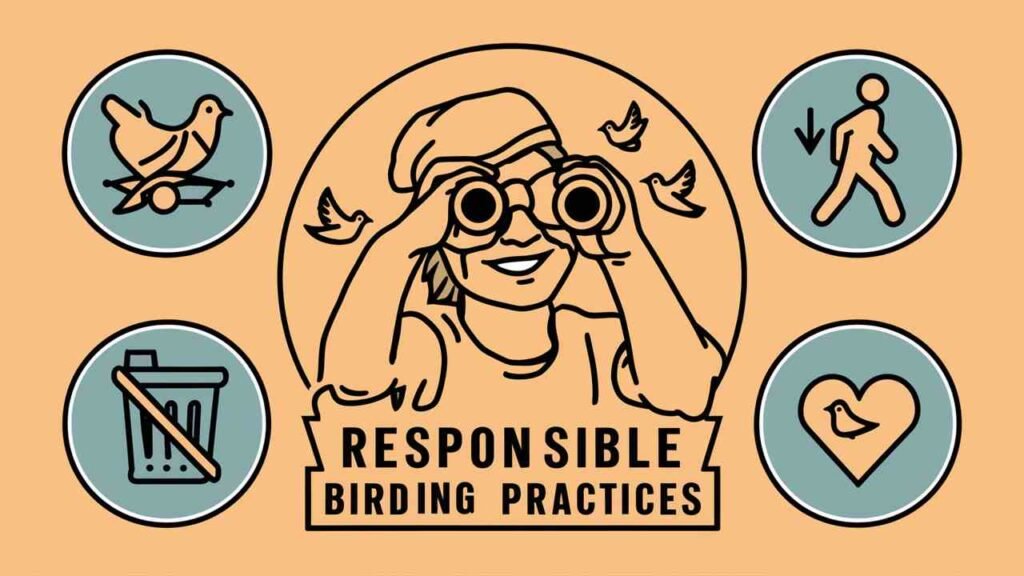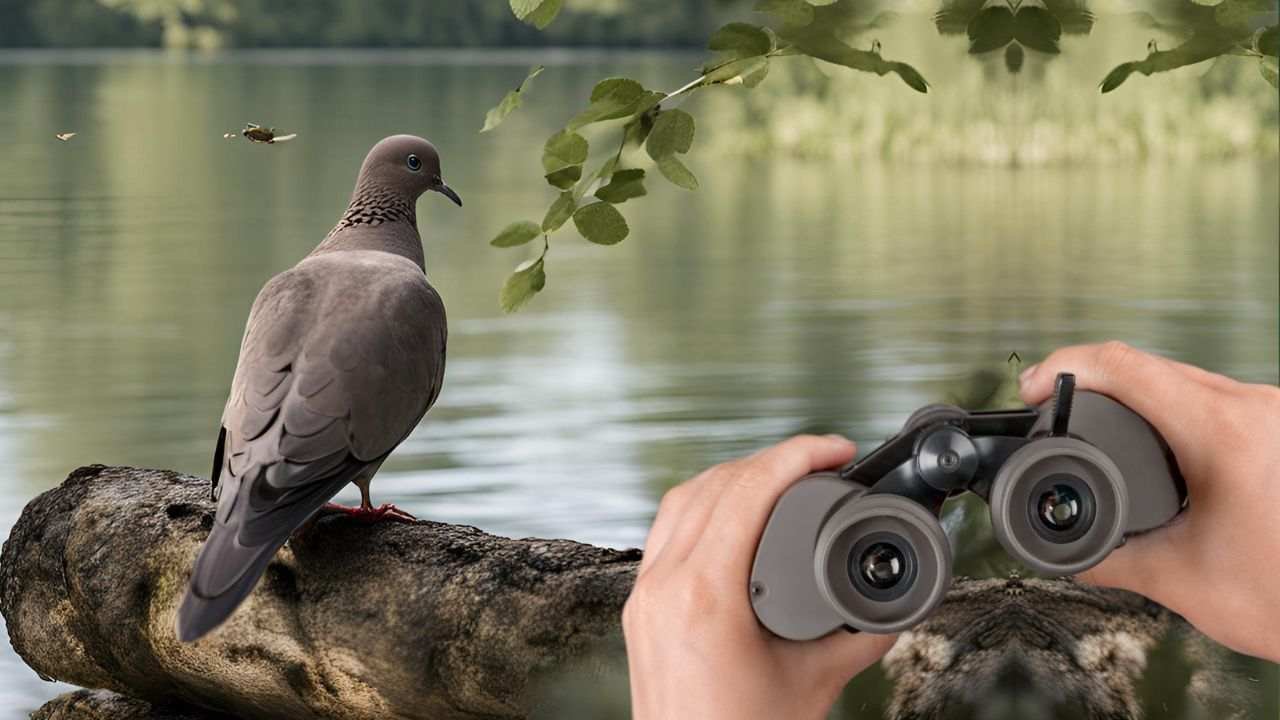Ever been drawn in by a dove’s soft coo and wondered who’s visiting? Distinguishing these birds can be tricky due to their look-a-like features. This is especially true for newbie bird watchers. But no worries, outdoor lovers!
Consider this your handy guide, filled with all you need to spot doves with your binoculars like a pro. We’ll talk about their standout features, delve into the peculiar things they do, and even decode their distinctive coos. With this guide’s help, you’ll move from simply watching to expertly identifying these birds!
Gearing Up for Dove Discovery: Binoculars and Field Guides
Choosing the Right Binoculars:
- Magnification and Field of View: Look for doves using an 8x-10x magnification. It gives a clear, close view, and also keeps a wide view, which is important for spotting flying doves. A broad view (like 350-400 feet at 1,000 yards) helps finding doves faster, especially in open areas where doves like to be.
- Catching First Light: Doves usually stir as day breaks and night settles, or in shadowy spots. Using binoculars with a bigger objective lens diameter, like 42mm or 50mm, lets more light in. This means you’ll see doves clearer and brighter, even when the light’s low.
Binocular Recommendations for Dove Identification:
| Feature | Importance for Dove Identification | Recommendation |
|---|---|---|
| Magnification | Provides a clear close-up view for spotting details | 8x to 10x |
| Field of View | Allows for quicker spotting in open habitats | 350-400 feet at 1,000 yards |
| Objective Lens Diameter | Improves image clarity in low-light conditions | 42mm or 50mm (larger is better) |
| Weight and Size | Affects comfort during extended birding sessions | Choose a comfortable option for holding and carrying |
Field Guide Essentials for Doves:
Remember, your bird book is your go-to buddy out there. Pick a top-notch one, dedicated to your area’s birds. It needs information about dove types, like size, feather styles, sounds, and favorite places to hang out. Drawings and area charts boost your bird spotting powers.

Unraveling Dove Traits: Essential Features for Bird Watching with Binoculars.
Now you’ve got the right tools, let’s explore the main features that will assist you in identifying different dove species:
- Size and Silhouette: When thinking about size and shape, doves are quite diverse. Take the Mourning Doves for example! They sport a skinny physique and long tails. Contrastingly, Rock Doves look stronger with their short tails. And then we have Ground Doves – they’re smaller and spend more time on the ground compared to other doves.
- Examining Bird Colors: Look at the whole bird, from beak to tail. Notice the head, chest, wings, and tail marks. Mourning Doves? They’re mostly brown, with black dots on wings and a white tail tip. Rock Doves are different. You can see a rainbow-like glow on their necks and sometimes they’re all white, like the “White Dove.”
- Looking at Beaks: Dove beaks are usually small, thin, but they can differ a bit. How? Take Inca Doves for example, they sport a slightly longer, straighter beak than the Common Ground Dove would.
Understanding Dove Actions: Activity and Vocal Sounds
Apart from how it looks, a dove’s actions can give important hints for knowing what it is:
Concentrating on Actions and Activity
- Flight Patterns: Doves are known for their different ways of flying. For instance, Mourning Doves fly fast and flap their wings quickly with brief moments of gliding. But Rock Doves, they fly differently. They take a straight path, flap their wings but they glide sometimes too.
- Feeding Habits: See where and how doves gather their food. Mourning Doves and Rock Doves mostly eat from the ground, but you might see Inca Doves up in trees, nibbling on fruits and seeds.
- Habitat Preferences: Various doves like different places. Open fields and farming lands attract Mourning Doves. However, city landscapes are home to Rock Doves. Ground Doves, fitting their title, go for spots with less greenery and open soil.
Identifying Doves through their Calls and Songs
Doves stand out due to their unique sounds. The Mourning Dove’s sad ‘woo-woo-woo’ sound stands out. Just as well, the Rock Doves make a deep, cooing sound, while the Inca Doves have a special whistle-like song. You can quickly know typical dove sounds by listening to audio clips in your guidebook or online resources.
Checking Your Field Manual With Binocular Viewings
Binoculars alone are not enough. After you’ve noticed how big or small a dove is, what it looks like, its colors, and how it acts, have a look at your bird book. Here you’ll compare what you saw with clear details and drawings of the various kinds of doves around your place.
Spotting Dove Types and Helpful Hints
Here is a speedy rundown for recognizing frequent dove types found in North America:
- Mourning Dove: You can find this slim dove everywhere. It has a long tail, like a point. Its feathers are a mix of gray and brown. There are black spots on its wings and a white edge on its tail. The mourning dove has a sad sound. It goes “woo-woo-woo,” and you can’t mistake it for anything else.
- Rock Dove, also known as Rock Pigeon: You’ve probably seen these chunky city birds. They’re a bit bulkier than mourning doves, with not-so-long tails. When the light is just right, you can spot their shiny neck feathers. Their gray bodies stand out, marked with two black lines across their wings. The white doves you see around? They’re just rock doves with a color change. They lack the normal color scheme.
- Ground Dove: This bird kind is tinier than mourning doves and rock pigeons. It has a unique brief, rounded tail. Ground doves mostly live on the ground, regularly spotted searching for seeds on the forest ground.
| Dove Species | Size | Key Identification Features | Habitat Preference |
|---|---|---|---|
| Mourning Dove | Medium | Slender build, long tail, brown body with black wing spots, white-tipped tail | Open fields, agricultural areas, edges of woodlands |
| Rock Dove (including White Dove) | Stocky | Short tail, iridescent neck feathers (visible in good light), grey or white plumage variations | Urban settings, parks, buildings |
| Inca Dove | Small | Long tail, slender build, rufous tones on wings and back | Woodlands, edges of fields, gardens |
| Ground Dove | Small | Short, rounded tail, spends most of its time on the ground | Areas with low vegetation, exposed ground |
Example Challenges: Differentiating Similar Doves:
- Mourning Dove vs. Common Ground Dove: They might look the same initially, right? Yet, you’ll notice some differences. But there are differences. For example, the Mourning Dove’s tail is longer. It’s more distinct wing patterns also set it apart. On the other hand, the Ground Dove is smaller in size. It also has a shorter, round-shaped tail.
- Inca Dove vs. White-winged Dove: Both are small-sized doves with lengthy tails. The build of an Inca Dove is more slender, featuring a long, straight beak, and reddish hues on its wings and back. The White-winged Dove, however, has a shorter beak that bends down a bit and noticeable white patches on its wings.
Beyond the Basics: Advanced Techniques for Dove Enthusiasts
As you get better at recognizing doves, you can explore more with these progressive methods:
- How to tell Dove Genders Apart by Feather Differences: Some dove types show minor feather differences between males and females. For example, male Inca Doves may have a wider reddish-brown pattern on their wings than females. Check your bird guide for details specific to each kind of dove.
- Distinguishing Between Cryptic doves: Recognizing some specific dove species can be tough. Their seemingly similar feather patterns can be tricky. To pinpoint these “cryptic doves,” you might need a mix of clues like their actions, where they live, and their unique coos. Chats with seasoned bird-watchers in your neighborhood may help get a grip on these birds’ little peculiarities.
Responsible Birding Practices: Respecting Our Feathered Friends
As you begin your dove classification adventure, don’t forget to bird responsibly:
- Maintain a Safe Distance: Don’t go too near to doves, as this can bother them. Watch from a decent distance so they can continue their usual routines without fear.
- Minimize Disruptions: Doves can get scared with loud sounds or quick actions. When looking at birds, move gently and talk in a hushed voice.
- Leave No Trace: Love and respect our world. Don’t leave trash behind, and always clean up after yourself.

Conclusion
Bird watching doves with binoculars can be fun and challenging. Just grab a pair of binoculars that have 8x to 10x magnification and a broad view span (like 350-400 feet at 1,000 yards). Also, carry a handy field guide.
First, using your binoculars, take a look at a dove. Note things like size, form, and coat patterns. Check for any marks on the dove’s head, chest, wings, and tail. Remember its unique beak shape, and pay attention to what it’s doing. Does it fly in a particular pattern? How does it feed? Keep these details for later use. You might need binoculars with a big objective lens (such as 42mm or 50mm) for darker settings. Take your time and compare what you see to your field guide or clear pictures. Remember, it’s crucial to respect bird space, limit disruptions, and leave no trace.
By using your patience and this guide, you’ll become comfortable spotting doves, providing a richer bird watching trip.
Helpful Online Resources for Dove Identification
| Resource | Description |
| Xeno-Canto | Extensive library of bird calls and songs |
| Merlin Bird ID app (Cornell Lab of Ornithology) | Bird identification app with photos, sounds, and range maps |
| National Audubon Society – Field Guides | Online field guides with detailed descriptions and illustrations of North American birds |

